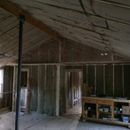Vapor retarder for exterior walls Zone 4
Good afternoon,
The insulation guys installed un-faced batts in the exterior walls in my house in Nashville Tn. Should I install a smart vapor barrier (certainteed membrain) over the insulation?
– The house was built in 1964 with thermo ply sheathing. As seen in the image the sheathing is very
leaky. I have done my best at sealing the sheathing with caulking and great stuff foam.
Thanks! ~Bob
GBA Detail Library
A collection of one thousand construction details organized by climate and house part










Replies
Bob,
Nashville, Tennessee, is in Climate Zone 4.
According to recent versions of the International Residential Code, walls in your climate zone are not required to have an interior vapor barrier or vapor retarder. For more information on these code requirements in colder climates, see Vapor Retarders and Vapor Barriers.
In your climate zone (as in all climate zones), it always makes sense to pay attention to airtightness at all stages of construction, including when you install the drywall.
It looks like fiberglass batts were installed between your rafters. I hope that you remembered to install a ventilation channel between the top of the insulation and the underside of your roof sheathing.
Martin - Thanks for the Response!
This is what the insulation company said -> that it will pass codes... my question is will it behoove me to install a smart vapor retarder or will it be OK as is with no retarder on the interior wall? I did my best sealing the Thermo ply(is this a vapor barrier?) from the inside but there will be some air leakage. The house is a brick exterior. the Drywall is going in on Monday - 5/8" on lofted ceilings and walls.
Thanks
See continuous baffles - they were a pain to install! Picture is before they were sealed up to the ridge.
Yes, foil faced sheathing is a vapor barrier, and that will protect the wall assembly from taking on moisture from the brick.
Buy a few rolls of high quality temperature rated foil tape (eg Nashua 324a, available at most box stores, but there are others) and tape all of the seams & holes on the foil faced sheathing. Then with a suitable sealant (polyurethane caulk is pretty good) caulk the perimeter of each stud bay to the sheathing, as well the seams in the doubled-up framing such as the window headers, top plate of the studwalls, as well as a bead between the bottom plate of the studwall and the subfloor. That will go a long way toward making the place air-tight.
In zone 4A you don't really need an interior side vapor retarder other than standard latex paint (3-5 perms). The foil faced sheathing isn't going to take on moisture as adsorb, and the wintertime temperature averages at the sheathing are high enough that there isn't going to be much wintertime moisture accumulation in the insulation, as long as you have 5 perm paint on wallboard and not a lot of air leakage through the wallboard.
Dana,
Your advice comes too late. See the photo posted with the original question -- all the Thermo-Ply has already been covered by fiberglass insulation.
Thermo-Ply has a vapor permeance of 0.53 to 0.63, making it a Class II vapor retarder.
I suppose it's not too late (and still worth it) to caulk the seams of the doubled-up framing and the bottom plates to the sub-floor. (sigh)
You guys are AwESoME! Thanks for the Responses!
Dana - I did my best at air sealing I did not tape the seams but -> the top and bottom plates were sealed as well as l the studs I deemed necessary with Dow enerfoam.
Thanks again for the help!